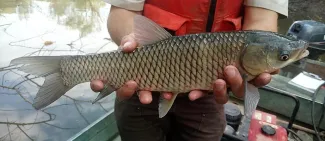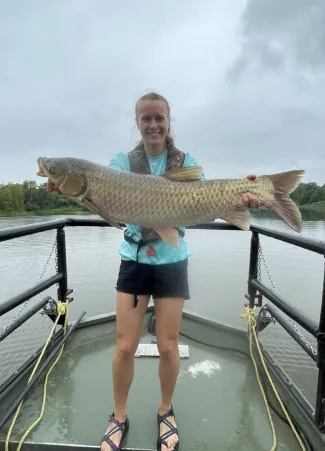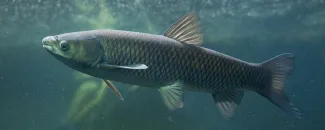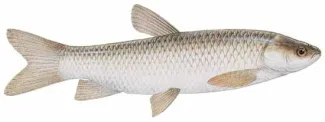Introduction
Grass carp were imported from eastern Asia in 1963 to control submersed aquatic vegetation in aquaculture ponds. Escapement from these aquaculture facilities occurred soon after importation and grass carp in the wild were first documented in the Mississippi River along Illinois in 1971. Since that time grass carp have rapidly spread to 45 states through the accidental and intentional, legal and illegal release by numerous state and federal agencies, private groups and individuals. Grass carp began to appear in the catches of Arkansas’ commercial fisheries in the early 1970's, and by 1976, 25 tons were reported taken statewide. Stocking of grass carp for control of aquatic vegetation was legalized in Oklahoma in the early 1980's.
Status and Impact
Currently grass carp are available for purchase for private use through commercial fish producers in the state. The Oklahoma Department of Wildlife Conservation (ODWC) currently uses grass carp on its four fish hatcheries for control of aquatic vegetation in culture ponds. Grass carp orient to flow and will quickly leave ponds when water is flowing over the spillway. Today grass carp can be found in most reservoirs in Oklahoma and reproduction of grass carp has been verified in Lake Texoma by ODWC biologists.
Negative impacts on native organisms have been summarized to include: competition for food with invertebrates (i.e., crayfish) and other fishes; significant changes in the composition of aquatic vegetation, phytoplankton, and invertebrate communities; interference with the reproduction of other fishes; modification or elimination of preferred fish habitats; enrichment and eutrophication of lakes; disruption of food webs and trophic structure; and introduction of nonnative parasites and diseases.
Key Identification
- Body is torpedo-shaped, blunt head, and moderately large scales
- Cross-hatched appearance from scales dark edges
- Olive brown with silver sides and a white belly
Regulations Pertaining to Grass Carp
800:20-1-2. List of restricted exotic species
Release of grass carp (diploid and/or triploid), also known as white amur or Chinese carp (Ctenopharyngodon idella) or their hybrids into public waters is prohibited in accordance with 29 O.S., Section 6-504. Only certified triploid grass carp may be imported, possessed, or introduced for the purpose of stocking private waters. Possession and transportation of diploid grass carp is permitted for the control of vegetation on licensed aquaculture facilities, the export to states allowing use of diploid grass carp and for production for sale to the human food market.



